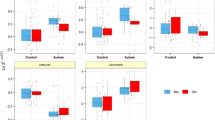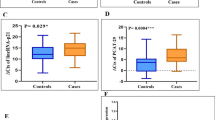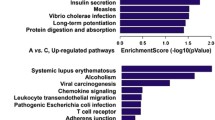Abstract
Long non-coding RNAs (lncRNAs) constitute a large proportion of human transcriptome and are involved in fundamental aspects of neurodevelopment. In the present study, we evaluated expression levels of three lncRNAs, namely, Nuclear Paraspeckle Assembly Transcript 1 (NEAT1), p21-associated ncRNA DNA damage–activated (PANDA), and taurine-upregulated gene 1 (TUG1), in peripheral blood of autism spectrum disorder (ASD) patients compared with those in healthy subjects. We found a significant upregulation of NEAT1 and TUG1 in ASD patients. In addition, relative expressions of the pairs of lncRNAs were significantly correlated in both patients and healthy subjects. However, expressions of these lncRNAs were not correlated with age of study participants. The present study provides further evidences for dysregulation of lncRNAs in ASD patients.
Similar content being viewed by others
Avoid common mistakes on your manuscript.
Introduction
Long non-coding RNAs (lncRNAs) constitute a large proportion of human transcriptome and are involved in the fundamental aspects of cell physiology (Taheri et al. 2018). More recently, their ample expression in the human brain and their participation in the development of neurological pathways have been documented (Tang et al. 2017). Such data have raised the possibility of their functional role in the pathology of neurodevelopmental disorders such as autism spectrum disorder (ASD). ASD with a worldwide prevalence between 0.25 and 2.64% is regarded as a prominent health problem with insufficient treatment modalities (Tang et al. 2017). Identification of molecular pathways involved in this disorder will help to design novel therapeutic options for patients. The critical role of lncRNAs in regulation of gene expression and their participation in diverse physiological functions make them putative targets in this regard. A bioinformatics approach for the integration of numerous genomic resources has identified several lncRNAs with differential expression in the ASD cortex, prominent expression in brain tissues, and co-expression with ASD risk genes in the growing cortex. Functional enrichment of these lncRNAs has shown their participation in synaptic signaling, transmission pathways, immune response, and lipid transport pathways. Dysregulation of these pathways in ASD further highlights the role of these lncRNAs in the pathogenesis of this disorder (Gudenas et al. 2017). Moreover, a genome-wide expression analysis of lncRNAs in peripheral blood ASD patients has led to identification of numerous differentially expressed lncRNAs participating in neurological pathways of the synaptic vesicle cycling, long-term depression, and long-term potentiation (Wang et al. 2015).
In the present study, we evaluated the expression of three lncRNAs, namely, Nuclear Paraspeckle Assembly Transcript 1 (NEAT1), p21-associated ncRNA DNA damage–activated (PANDA), and taurine-upregulated gene 1 (TUG1), in peripheral blood of ASD patients compared with that in healthy subjects to find putative peripheral biomarkers or therapeutic targets for ASD. The rationale for selection of these lncRNAs was their regulatory roles in cellular apoptosis (Hung et al. 2011; Yin et al. 2015; Peng et al. 2017). Apoptosis as a vital mechanism that governs the dimension and outline of the brain controls the appropriate connections of evolving neuronal networks. Aberrant stimulation of apoptotic pathways could result in neuroanatomic irregularities and probably to developmental diseases such as ASD (Wei et al. 2014).
Material and Methods
Study Participants
A total of 30 Iranian ASD patients (mean age of 6 ± 1.4) and 41 age- and gender-matched normal subjects (mean age of 6 ± 1.4) entered the study. Patients were diagnosed based on the criteria provided by Diagnostic and Statistical Manual of Mental Disorders, 5th edition (DSM-V) (Association 2013). Control subjects were age- and sex-matched with ASD patients. Controls were selected from individuals who had no history of behavioral/psychiatric disorder or prior psychiatric treatment in themselves or their first-degree relatives.
Quantitative Real-time PCR
Total RNA was isolated from peripheral blood samples using Hybrid-RTM blood RNA extraction Kit (Geneall Biotechnology Co Ltd., South Korea) according to the instructions. The extracted RNA was treated with DNase I to dispose DNA contamination. The quantity and quality of the extracted RNA were assessed by NanoDrop equipment (Thermo Scientific) and gel electrophoresis. First-strand cDNA was produced from RNA samples using the Applied Biosystems High-Capacity cDNA Reverse Transcription Kit. The relative expression level of lncRNAs in each study group was assessed using the Applied Biosystems TaqMan® Universal PCR Master Mix in rotor gene 6000 Corbett Real-Time PCR System. The HPRT1 gene was used as the reference gene. PCR program included a denaturation step at 95 °C for 10 min, followed by 40 cycles of 95 °C for 10 s and 60 °C for 60 s and a final extension step in 72 °C for 5 min. The nucleotide sequences of primers and probes used for amplification of lncRNAs are shown in Table 1.
Statistical Analysis
Statistical analyses were performed in SPSS version 18 (Chicago, IL, USA). Relative expression of lncRNAs in ASD patients compared with that in healthy subjects was evaluated based on calculation of Ln [efficiency^∆CT] values. The significance of difference in mean values of gene expressions between patients and healthy subjects was assessed using Bayesian multilevel regression model by adjusting the effects of age and sex. We considered observation effects as random in the model. A Student t prior distribution was assumed for parameters with 5000 iterations and 1000 warmups. Spearman’s rank-order correlation test was used to estimate the correlation between relative expression levels of lncRNAs and age of study participants. The effects of possible confounding variables such as age and sex were assessed using the median regression model. P values less than 0.05 were considered significant.
The receiver operating characteristic (ROC) curve was plotted to assess the appropriateness of lncRNA transcript levels for categorizing disease status. In order to estimate gene expression probability cutoff the Youden index (J) was used to maximize the difference between sensitivity (true-positive rate) and 1—specificity (false-positive rate). The accuracy of each marker for diagnosis of ASD was scored based on the area under curve (AUC) values using the following system: 0.90–1 = excellent (A), 0.80–0.90 = good (B), 0.70–0.80 = fair (C), 0.60–0.70 = poor (D), and 0.50–0.60 = fail (F).
Results
Expression of lncRNAs in ASD Patients and Healthy Subjects
NEAT1 was significantly upregulated in peripheral blood of ASD patients compared with that of healthy subjects (P = 0.024, 95% credible interval (CrI) = [1.06, 3.42]). Moreover, TUG1 peripheral expression was significantly higher in ASD patients compared with that in controls (P = 0.018, 95% CrI = [1.69, 6.58]). Expression of PANDA was not significantly different between cases and controls (P = 0.102). Table 2 shows the results of Bayesian multilevel regression model for association between gene expression and ASD.
After the application of median regression model for adjusting the effects of sex and age, there was a significant difference in expression of NEAT1 and TUG1 between patient and control groups. The interaction between gene expression and sex was insignificant for all three lncRNAs. Table 3 shows the results of median regression model for assessment of association between expression levels of genes and ASD.
Correlation Between Relative Expressions of lncRNAs in Study Participants
Relative expressions of the pairs of lncRNAs were significantly correlated in both patients and healthy subjects including individuals of both sexes. Table 4 shows the correlation coefficients between expression levels of lncRNAs in study subgroups.
However, expressions of these lncRNAs were not correlated with age of study participants. Table 5 shows Spearman’s correlation coefficients between expression levels of lncRNAs and age in subgroups of study participants.
ROC Curve Analysis
NEAT1 had the best AUC value (AUC = 0.759). PANDA had the best sensitivity for detection of disease status. Table 6 shows the results of ROC curve analysis.
Discussion
Participation of lncRNAs in synaptogenesis, neurogenesis, and GABAergic transmission implies their possible role in the pathogenesis of ASD (Tang et al. 2017). Dysregulation of several lncRNAs has been documented in ASD patients albeit the functional importance of them has not been elucidated (Wang et al. 2015). In the present study, we evaluated the expression of three lncRNAs in the peripheral blood samples of ASD patients compared with that of normal subjects and found a significant upregulation of NEAT1 and TUG1 in ASD patients.
NEAT1 RNA is kept in nuclei in foci that are entirely parallel with paraspeckles. These subcellular organizations participate in mRNA nuclear retention. NEAT1 RNA interacts with paraspeckle proteins and has a fundamental role in regulation of the paraspeckle quantity in the nucleus (Clemson et al. 2009). Although the role of NEAT1 in synaptogenesis has not been explored yet, the established role of another long nuclear-retained lncRNA in the regulation of synaptogenesis (Bernard et al. 2010) suggests a similar role for NEAT1 in this process. Besides, NEAT1 has been shown to regulate the expression of brain-derived neurotrophic factor (BDNF) through enhancing the expression of miR-497 in the retina (Li 2018). Both BDNF and miR-497 have been shown to be involved in the pathogenesis of brain disorders. miR-497 has a role in aggravation of oxygen-glucose deprivation (OGD)–induced neuronal cell death and the ischemic brain injury in stroke (Yin et al. 2010). On the other hand, peripheral BDNF levels have been shown to be significantly higher in ASD patients compared with those in controls which imply contribution of BDNF in the pathogenesis of ASD (Saghazadeh and Rezaei 2017). Consequently, elevated levels of NEAT1 as revealed in the current study might be implicated in the pathogenesis of ASD via miR497/BDNF pathway.
Tug1 has been among lncRNAs with spatiotemporal differential expression in brain regions. In adult brains, Tug1 expression was identified in dispersed cells in the neocortex. Animal studies have shown a significant upregulation of numerous adjacent genes in brain tissues of the Tug1 knocked-out mice implying cis-acting role of this lncRNA in regulation of gene expression (Goff et al. 2015). The expression of Tug1 in the neocortex of mice on one hand and detected areas of disorganization in the neocortex of ASD children (Stoner et al. 2014) on the other hand are consistent with the results of the current study regarding upregulation of TUG1 in peripheral blood of ASD patients. Moreover, TUG1 has been among lncRNAs with upregulation in cerebral ischemic animals and/or OGD cells. This lncRNA alters cell apoptosis, inflammation, and angiogenesis in the course of ischemic stroke. TUG1 exerts inhibitory effects on miR-9 (Bao et al. 2018), an evolutionary conserved miRNA whose overexpression has been associated with behavioral deficits in animals (Shi et al. 2018). On the other hand, downregulation of miR-9 in postmitotic neurons has been detected in some neurodegenerative diseases (Yuva-Aydemir et al. 2011). This miRNA also influences proliferation, migration, and differentiation of neural progenitor cells (Yuva-Aydemir et al. 2011). Taken together, aberrant expression of TUG1 in ASD patients as demonstrated in our study might be implicated in the pathogenesis of ASD via alteration of expression of miR-9 and subsequently several mRNAs that are influenced by this miRNA.
We also demonstrated significant correlations between expression levels of these three lncRNAs in all study subgroups which might suggest the presence of a common regulatory mechanism for these lncRNAs. In addition, such correlations allow estimation of transcript levels of these lncRNAs based on transcript level of single one. However, we could not find any correlation between expression of these lncRNAs and age either in cases or in controls. So expression levels of these lncRNAs might be suggested as age-independent markers of disease. Previous studies have demonstrated an age-dependent increase in TUG1 expression in human subventricular zone (Barry et al. 2015) which is not in line with our results. Such inconsistency can be explained by different patterns of gene expression in different tissues.
In brief, in the current study, we demonstrated the dysregulation of two lncRNAs in peripheral blood of ASD patients which might affect the disease through alterations in apoptotic or neurogenic pathways not only in peripheral blood but also in brain tissue. The latter is supported by the proposed role of the neuroimmune interface in modification of neuroplasticity and the evolution of ASD (Gottfried et al. 2015). However, future in vitro studies are needed to assess the consequences of this dysregulation at cellular level. Moreover, a non-biased approach of RNA sequencing would help in identification of other lncRNAs that might be involved in the pathogenesis of ASD. Our study has also another limitation regarding lack of functional studies and interference tests to explore the role of mentioned lncRNAs.
Finally, we have assessed the suitability of expression profile of these lncRNAs in ASD diagnosis. NEAT1 had the best performance among these lncRNAs based on the AUC value. However, PANDA had the best sensitivity for detection of disease status. Based on these observations, we suggest future studies to be conducted in larger sample sizes of ASD patients to evaluate appropriateness of lncRNA expression profile as diagnostic biomarkers in ASD.
References
Association AP (2013) Diagnostic and statistical manual of mental disorders (DSM-5®), American Psychiatric Pub
Bao MH, Szeto V, Yang BB, Zhu SZ, Sun HS, Feng ZP (2018) Long non-coding RNAs in ischemic stroke. Cell Death Dis 9:281
Barry G, Guennewig B, Fung S, Kaczorowski D, Weickert CS (2015) Long non-coding RNA expression during aging in the human subependymal zone. Front Neurol 6:45
Bernard D, Prasanth KV, Tripathi V, Colasse S, Nakamura T, Xuan ZY, Zhang MQ, Sedel F, Jourdren L, Coulpier F, Triller A, Spector DL, Bessis A (2010) A long nuclear-retained non-coding RNA regulates synaptogenesis by modulating gene expression. EMBO J 29:3082–3093
Clemson CM, Hutchinson JN, Sara SA, Ensminger AW, Fox AH, Chess A, Lawrence JB (2009) An architectural role for a nuclear noncoding RNA: NEAT1 RNA is essential for the structure of paraspeckles. Mol Cell 33:717–726
Goff LA, Groff AF, Sauvageau M, Trayes-Gibson Z, Sanchez-Gomez DB, Morse M, Martin RD, Elcavage LE, Liapis SC, Gonzalez-Celeiro M, Plana O, Li E, Gerhardinger C, Tomassy GS, Arlotta P, Rinn JL (2015) Spatiotemporal expression and transcriptional perturbations by long noncoding RNAs in the mouse brain. Proc Natl Acad Sci U S A 112:6855–6862
Gottfried C, Bambini-Junior V, Francis F, Riesgo R, Savino W (2015) The impact of neuroimmune alterations in autism spectrum disorder. Front Psychiatry 6:121
Gudenas BL, Srivastava AK, Wang L (2017) Integrative genomic analyses for identification and prioritization of long non-coding RNAs associated with autism. PLoS One 12:e0178532
Hung T, Wang YL, Lin MF, Koegel AK, Kotake Y, Grant GD, Horlings HM, Shah N, Umbricht C, Wang P, Wang Y, Kong B, Langerod A, Borresen-Dale AL, Kim SK, Van De Vijver M, Sukumar S, Whitfield ML, Kellis M, Xiong Y, Wong DJ, Chang HY (2011) Extensive and coordinated transcription of noncoding RNAs within cell-cycle promoters. Nat Genet 43:621–U196
Li XJ (2018) Long non-coding RNA nuclear paraspeckle assembly transcript 1 inhibits the apoptosis of retina Muller cells after diabetic retinopathy through regulating miR-497/brain-derived neurotrophic factor axis. Diab Vasc Dis Res 15:204–213
Peng W, Wang Z, Fan H (2017) LncRNA NEAT1 impacts cell proliferation and apoptosis of colorectal cancer via regulation of Akt signaling. Pathol Oncol Res 23:651–656
Saghazadeh A, Rezaei N (2017) Brain-derived neurotrophic factor levels in autism: a systematic review and meta-analysis. J Autism Dev Disord 47:1018–1029
Shi Z, Piccus Z, Zhang X, Yang H, Jarrell H, Ding Y, Teng Z, Tchernichovski O, Li X (2018) miR-9 regulates basal ganglia-dependent developmental vocal learning and adult vocal performance in songbirds. Elife 7
Stoner R, Chow ML, Boyle MP, Sunkin SM, Mouton PR, Roy S, Wynshaw-Boris A, Colamarino SA, Lein ES, Courchesne E (2014) Patches of disorganization in the neocortex of children with autism. N Engl J Med 370:1209–1219
Taheri M, Omrani MD, Ghafouri-Fard S (2018) Long non-coding RNA expression in bladder cancer. Biophys Rev 10:1205–1213
Tang J, Yu Y, Yang W (2017) Long noncoding RNA and its contribution to autism spectrum disorders. CNS Neurosci Ther 23:645–656
Wang Y, Zhao X, Ju W, Flory M, Zhong J, Jiang S, Wang P, Dong X, Tao X, Chen Q, Shen C, Zhong M, Yu Y, Brown WT, Zhong N (2015) Genome-wide differential expression of synaptic long noncoding RNAs in autism spectrum disorder. Transl Psychiatry 5:e660
Wei H, Alberts I, Li X (2014) The apoptotic perspective of autism. Int J Dev Neurosci 36:13–18
Yin KJ, Deng Z, Huang H, Hamblin M, Xie C, Zhang J, Chen YE (2010) miR-497 regulates neuronal death in mouse brain after transient focal cerebral ischemia. Neurobiol Dis 38:17–26
Yin D-D, Zhang E-B, You L-H, Wang N, Wang L-T, Jin F-Y, Zhu Y-N, Cao L-H, Yuan Q-X, De W (2015) Downregulation of lncRNA TUG1 affects apoptosis and insulin secretion in mouse pancreatic β cells. Cell Physiol Biochem 35:1892–1904
Yuva-Aydemir Y, Simkin A, Gascon E, Gao FB (2011) MicroRNA-9: functional evolution of a conserved small regulatory RNA. RNA Biol 8:557–564
Funding
The current study was supported by a grant from Shahid Beheshti University of Medical Sciences.
Author information
Authors and Affiliations
Corresponding authors
Additional information
Publisher’s Note
Springer Nature remains neutral with regard to jurisdictional claims in published maps and institutional affiliations.
Rights and permissions
About this article
Cite this article
Sayad, A., Omrani, M.D., Fallah, H. et al. Aberrant Expression of Long Non-coding RNAs in Peripheral Blood of Autistic Patients. J Mol Neurosci 67, 276–281 (2019). https://doi.org/10.1007/s12031-018-1240-x
Received:
Accepted:
Published:
Issue Date:
DOI: https://doi.org/10.1007/s12031-018-1240-x




